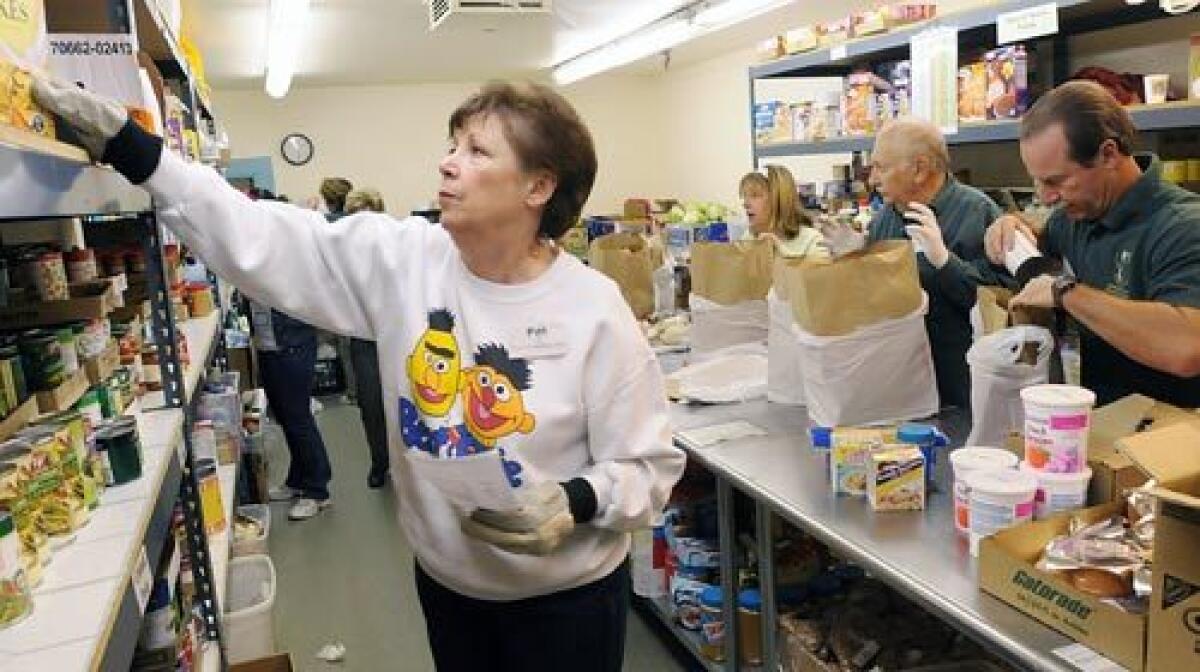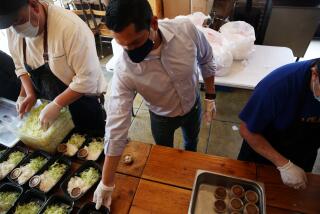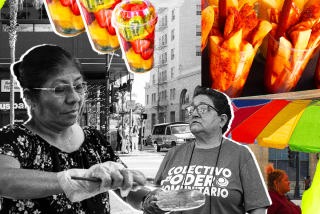Food shortage hits charity pantries

To Gladys Jacques’ relief, a grocery bag filled with chicken, bread and canned corn or string beans arrives on her doorstep once a month, delivered by church volunteers.
Retired, the 76-year-old registered nurse lives alone in South Los Angeles on a small Social Security income, hindered by diabetes and a stroke that makes it hard for her to walk. So the monthly deliveries from Bethel AME Church’s food pantry help Jacques get by when times are tight.
“I’ll eat anything they give me,” Jacques said of the periodic restocking of her shelves.
But those who run food banks say they are struggling. The supply of donated food is at its lowest level in recent memory, largely because of a steep decline in government surpluses. Many who work in the field are concerned that low-income people like Jacques may go hungry -- a worry they say is heightened by a growing number of households, particularly those with children, who report that they do not always know where their next meal is coming from.
“The state of food banks, I think, in America -- and in Los Angeles in particular -- is really in dismal shape,” said H. Eric Schockman, president of Mazon, a Los Angeles nonprofit group that funds hunger relief agencies in the U.S. and abroad. “Our emergency food system has really been unraveled over the last few years.”
Advocates like Schockman and food bank operators across the state and nationwide say they are scrambling to find new sources of nutritional food. Their hopes are pinned in large part to a nearly $300-billion farm bill scheduled to go before President Bush next month that could nearly double federal money available to supplement a dwindling supply of surplus food.
In California, the drop has been precipitous. Since 2002, donations of cheese, canned corn and beans, all longtime food bank staples, have been cut by more than half, from nearly 100 million pounds a year to 40 million. The difference, say officials from the California Assn. of Food Banks, translates into 44.7 million fewer meals for hungry people around the state.
And although local food pantries aren’t shutting their doors, some are having to scale back hours or offer less.
A combination of factors have pushed food banks, the massive warehouses that stock the food pantries at churches and other organizations, to the breaking point. Chief among them is a sharp drop in surplus commodities from the U.S. Department of Agriculture. With brisk overseas trade and farm prices strong in recent years, the government hasn’t had to buy as many excess peaches, or as much surplus asparagus, chicken or other goods, which would then be distributed to food banks across the country.
Food banks receive about one-fifth of their inventory from the federal government, said Kate Houston, deputy undersecretary for the USDA’s Food, Nutrition and Consumer Services. Under agricultural policies designed to support farmers, the federal government bought $319 million worth of these extra commodities in 2001; that number shrank to $67 million five years later, she said.
Making matters worse, food manufacturers themselves have grown more efficient, with fewer extra and substandard -- but still edible -- items to donate, said Ross Fraser, spokesman for America’s Second Harvest, a national network of food banks. And what extra goods there are often end up on discount store shelves.
“This is not crying wolf,” said Kim McCoy Wade, executive director of the California Assn. of Food Banks, which comprises 40 food banks across the state. “There’s no question that certain sources of food are declining.”
But just as food bank cupboards have grown emptier, more families are asking for help putting dinner on the table, providers say.
“The vast majority of the people who use the services of the food bank, they’re working poor, both breadwinners husband and wife,” said John Knapp, president of the Food Bank of Southern California.
The problem is acute in Los Angeles, where housing and transportation costs, both of which rose sharply over the past year, gobble up much of a low-income family’s budget.
The number of Los Angeles County households whose food supply is shaky increased 17% between 2002 and 2005; hungry families with children grew at an even faster clip, according to a report released last fall by the county department of public health. The report measured “food insecurity,” or people’s inability to dependably obtain adequate or nutritious food, based on the department’s most recent data from wide-ranging public health surveys given randomly by telephone every two to three years.
“I think we’re seeing some people who were middle class and making it, and then suddenly life changed for them,” said Leslie Friedman, director of the SOVA Community Food and Resource Program of Jewish Family Service of Los Angeles, which has three food pantries that offer food and social service help around the region. Volunteers at the organization’s bustling Van Nuys headquarters packed custom-ordered bags including bananas, pumpkin pie, applesauce, stew and other staples for 100 clients on one recent December day. Clients include working parents, senior citizens, people with disabilities and the unemployed, she said.
To help feed those people, food banks and the pantries they serve have been forced to get creative to make up the shortfall, stocking more fresh fruits and vegetables, buying more food and fundraising more aggressively, said Michael Flood, president and chief executive of the Los Angeles Regional Foodbank.
Nonetheless, food shortages have diminished the help that local charities can provide. The food pantry at Bethel AME Church, where Jacques is a member, used to stay open twice a week; now it’s open just once every two weeks, said Maurice Harper, coordinator of the public food department there. And they’re getting about half the quantity of food that they used to.
“I don’t have as many things to hand out,” said Millard Walton, director of House of Hope Burning Bush, an East Hollywood rooming house with a food pantry and soup kitchen. “I still have to feed everybody.”
susannah.rosenblatt
@latimes.com
More to Read
Start your day right
Sign up for Essential California for news, features and recommendations from the L.A. Times and beyond in your inbox six days a week.
You may occasionally receive promotional content from the Los Angeles Times.






